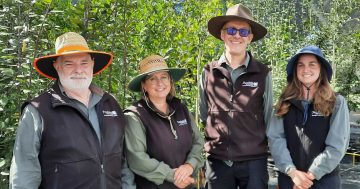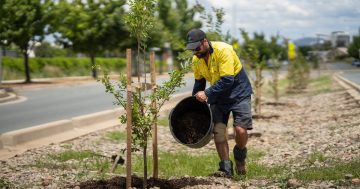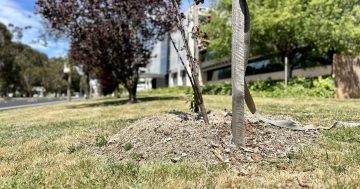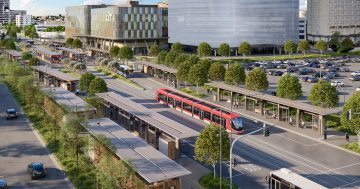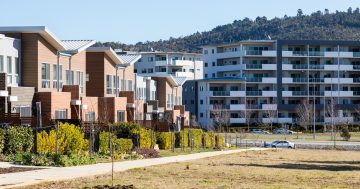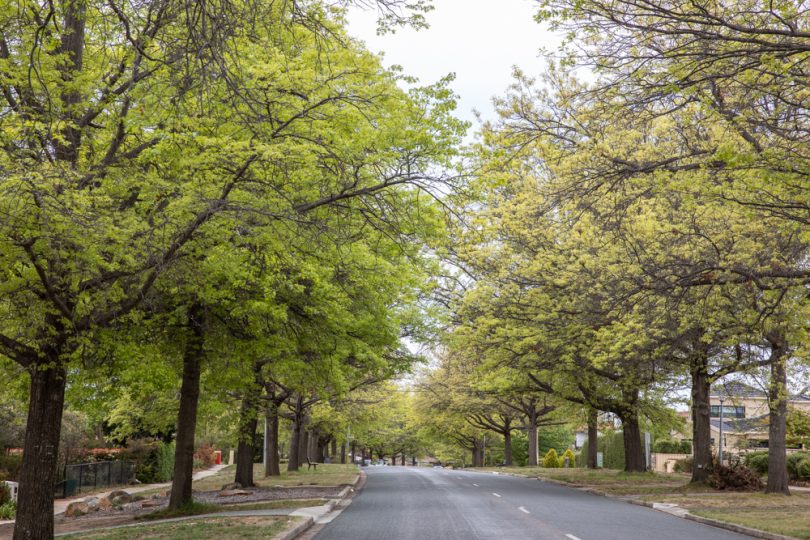
Oak trees provide a cooling canopy in summer. Photo: Michelle Kroll, Region Media.
The heat is on Canberra’s much-loved deciduous trees with a new report rating native varieties as the best species to cope with the ACT’s changing climate, with the kurrajong on top.
Commissioned by the ACT Government, the Urban Tree Species report from the ANU Fenner School of Research identified the best tree species to improve Canberra’s urban tree canopy and adapt to rising temperatures.
It comes after the release last month of Canberra’s Living Infrastructure Plan, alongside the ACT’s Climate Change Strategy, which outlined how the city can be cooled in a warming climate, including increasing urban tree canopy cover from 21 per cent to 30 per cent.
Using climate change models and species-specific data, the report reviewed the Transport Canberra and City Services (TCCS) tree list to determine which species will survive and thrive in Canberra’s climate change future, ranking species according to their climate suitability, capacity as street trees and advising which species are more suitable in certain scenarios.
It assessed and ranked tree species on a range of climate factors including drought tolerance, frost tolerance, extreme heat tolerance, weed potential and allergen potential.
The report assessed 211 tree species used in Canberra’s urban spaces and two lists, one climate-weighted, of top 50 species are dominated by native species, including eucalypts such as yellow box.
There are no exotic deciduous species in the top 10, but various drought-tolerant oaks and liquidamber are listed as well as the indigenous deciduous white cedar.
Other species include various pines and cypresses, crape myrtles, casuarina and acacia. It suggests trialling other native trees such as lemon-scented gum, spotted gum, wilga and silky oak, and even the purple flowering jacaranda which does well in Dubbo.
Despite its resilience and shady canopy, the report recommends popular oriental plane trees be used sparingly due to allergenic pollen.
The report selected trees as best to cope in a Canberra which is forecast to have a climate more like Dubbo, with temperatures up to 4 degrees Celsius higher by 2090. Although rainfall is tipped to remain steady, it will be delivered more in storm bursts than in soaking falls, where water is more likely to run off, particularly in paved environments.
The authors also rule out the mass irrigation of trees across the Canberra urban forest but argue for better planting methods and conditions, and greater stormwater retention.
They also argue for a greater diversity of plantings.
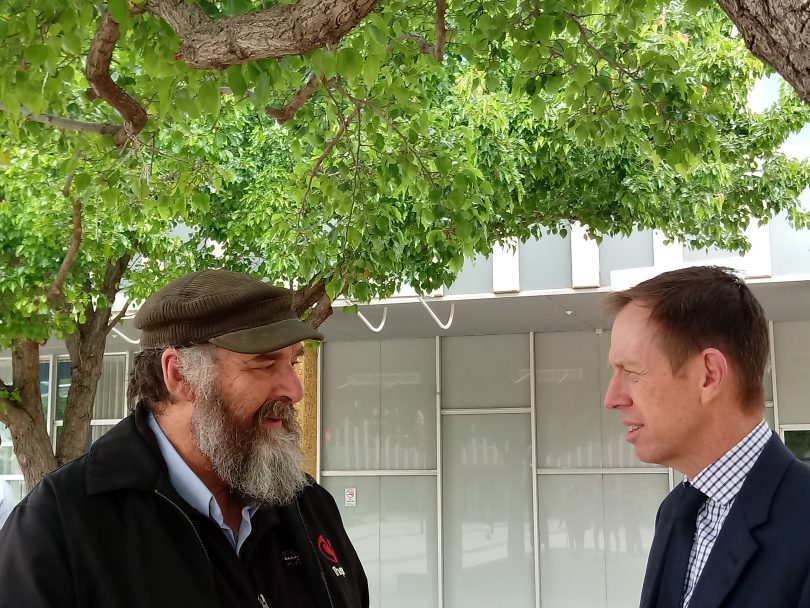
Associate Professor Cris Brack and Climate Change Minister Shane Rattenbury.
The report warns that climate change, combined with urban heat island effects and the stress of built environments, may lead to large-scale tree and urban forest failure.
“In south-east Australian cities, the combination of heat output from built infrastructure and climate change-related variability in rainfall and temperature regimes mean that tree decline associated with increasing urban drought severity and frequency is a principal concern for urban tree managers,” it says.
While the report clearly favours native species, it says there are no trees on the TCCS list that are not suitable for Canberra.
Climate Change Minister Shane Rattenbury said the government wanted to plant a lot more trees to protect the city against rising temperatures.
“We need to make sure we’re planting the right ones,” he said. “It’s quite an important report and will help shape the future of this city in terms of what trees are being planted.”
Mr Rattenbury said the Government had not made an explicit decision to turn away from exotic deciduous species to give the urban forest a more native bent, saying the city needed different species in different places to serve different purposes.
“Many of the trees are reaching the end of their natural lives so we’re going to see change over the coming decades, having the community more involved will make that change easier,” he said.
He said the Government did want to get rid of exotic species but some won’t survive the heat.
“Canberrans really love that autumn landscape in the city. It’s not that we want to get rid of it, that’s where we’ll have to work very carefully. The report does identify some of those deciduous species that remain viable in Canberra. Some won’t because they won’t cope in the heat. They’re some of the decisions we’ll have to take,” he said.
Mr Rattenbury said the tree program was expensive and he would like to see more of the community involved at a neighbourhood level to determine what species are planted and how they are maintained, including watering.
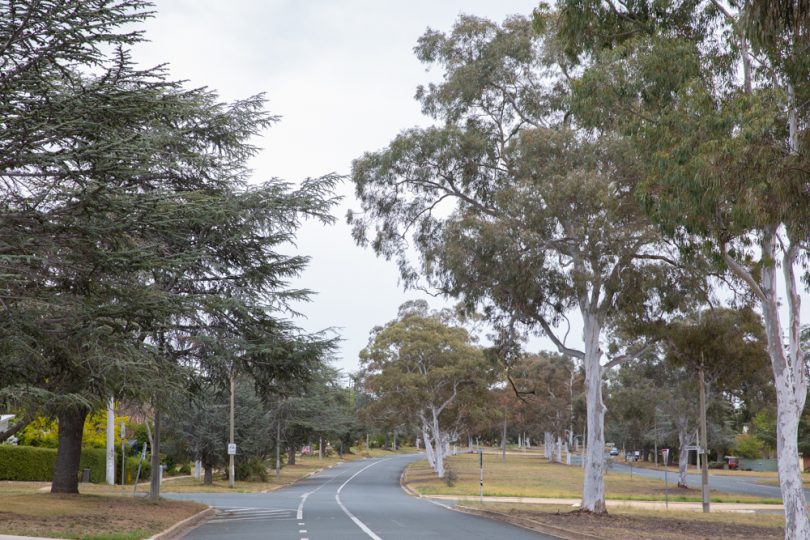
We’re more likely to see more eucalypts like these. Photo: Michelle Kroll
He also flagged more onerous conditions for developers to ensure there is decent tree cover and that they are maintained for a time post-development.
“Ideas are being discussed, how do we keep them alive, and make the program more affordable,” he said. “I don’t think it’s the Government’s sole responsibility to deliver it,” Mr Rattenbury said.
One of the authors, Associate Professor Cris Brack, said there would be a mix of natives and exotics that would survive, and the more diversity the better.
But he said perceptions that all eucalypts were not as cooling as exotics were, dropped limbs and were more of a fire hazard were misplaced.
“There is a perception that eucalypts don’t shade as much as exotics, but they do have very important cooling and climate mitigation effects,” he said.
“Eucalypts don’t give much shade at midday but the really big cooling effect is evapotranspiration or how the water moves through the leaves and cools down. Shading is one component but evapotranspiration is a major component. Maybe midday is not the time we need the shade, maybe its morning and late afternoon, when we’re being active.”
He said there were 800 species of eucalypt so it would be a matter of improved tree selection.
Eucalypts in streetscapes were not a fire risk, but he said different species should be planted on the urban interface.













